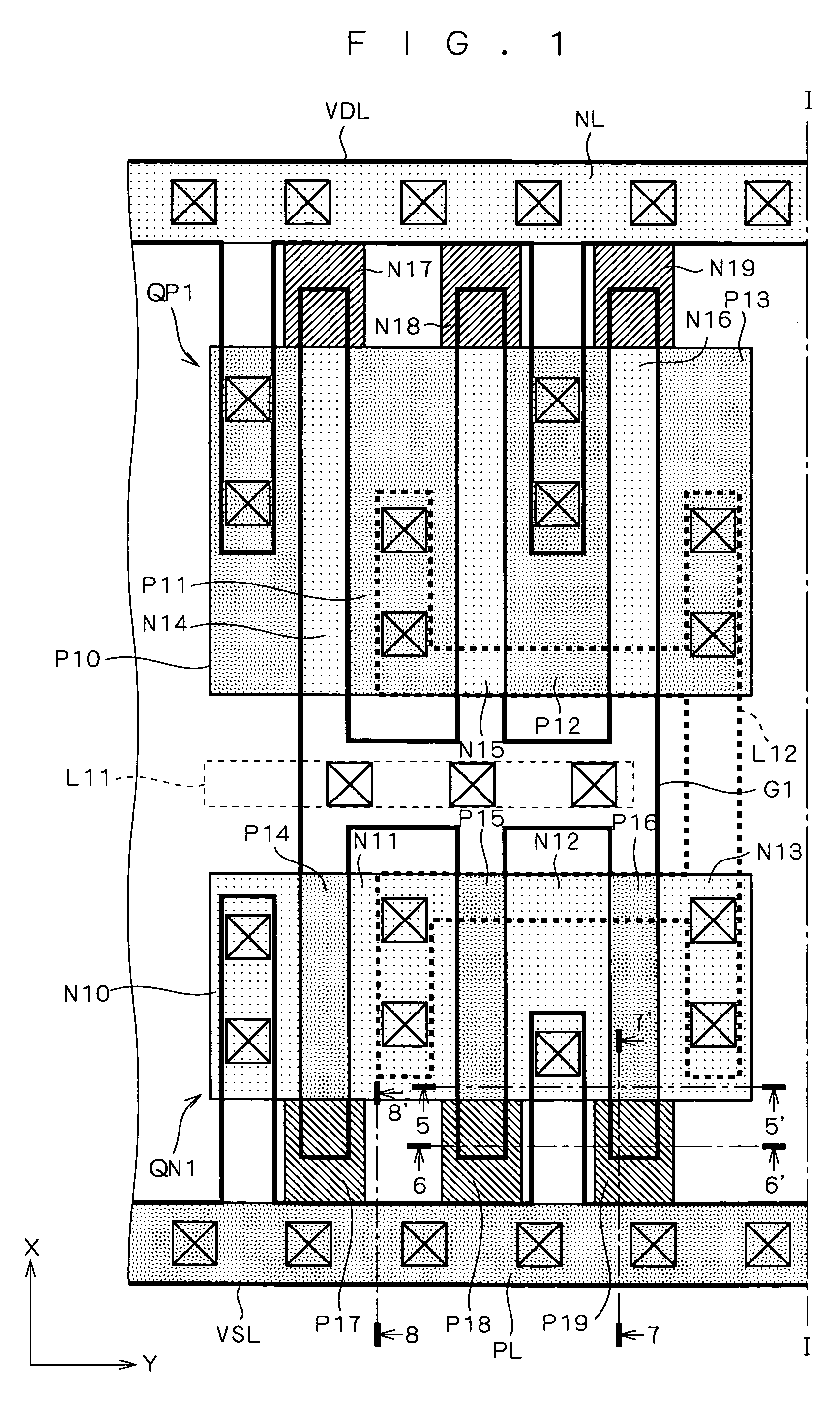Semiconductor device, method of manufacture thereof and semiconductor integrated circuit
a semiconductor and integrated circuit technology, applied in the field of element isolation techniques, can solve the problems of increasing the formation of the pn junction, and the increase of the parasitic capacitance of the source and drain region, so as to reduce the parasitic capacitance of the parasitic junction and reduce the parasitic capacitance of the wiring
- Summary
- Abstract
- Description
- Claims
- Application Information
AI Technical Summary
Benefits of technology
Problems solved by technology
Method used
Image
Examples
first preferred embodiment
[0040]FIGS. 1 to 3 are plan views together illustrating an element isolation technique according to a first preferred embodiment of the present invention. FIG. 4 is a schematic view depicting connections of FIGS. 1 to 3. FIGS. 1 and 2 are connected along an imaginary line I-I, and FIGS. 2 and 3 along an imaginary line II-II, to form the whole of the plan views.
[0041]In FIGS. 1 to 3, a gate array is illustrated in which a low potential line VSL, a group of NMOS transistors, a group of PMOS transistors, and a high potential line VDL are arranged in this order with respect to a direction (positive direction of an X direction) from the lower part to the upper part in the drawings. The low potential line, the high potential line, the group of NMOS transistors and the group of PMOS transistors are all formed in an SOI substrate (not shown). The application to a gate array should not be construed as limiting the present invention.
[0042]Each of the low potential line VSL and the high potent...
second preferred embodiment
[0085]As illustrated in FIG. 3, the gate width of the transistors QP4 and QN4 is narrower than the gate widths of the transistors QP1 to QP3 and QN1 to QN3. In order to reduce the resistance of the gate electrode G4 that is used both in the transistors QP4 and QN4, it is desirable that the transistors QP4 and QN4 be arranged close to each other with respect to the X direction.
[0086]Such arrangement, however, causes the N-type impurity layer N44 and the P-type impurity layer P44 in the PTI regions to increase in length in the X direction. A current flows in the X direction through the N-type impurity layer N44 that is interposed between and adjacently to the N-type impurity layers NL and N43. The same thing occurs in the P-type impurity layer P44. It is therefore desirable from the viewpoint of reducing the resistance of the impurity regions for fixing the body region potentials that the width with respect to the Y direction of the PTI regions be increased.
[0087]However, the simple w...
third preferred embodiment
[0103]An LSI (large scale integrated circuit) is often designed and manufactured by being divided into a plurality of blocks. For example, the design and manufacture are often conducted by mixing a block (hereafter called a “Type I block”) forming a circuit of relatively low degree of design freedom such as a cell base and a gate array used to form a logic circuit, and a block (hereafter called a “Type II block”) forming a circuit of relatively high degree of design freedom such as a SRAM (static RAM), a PLL (phase locked loop), an ADC (analog / digital converter), a DAC (digital / analog converter) and an I / O (input / output circuit). This applies to when designing and manufacturing an LSI on an SOI substrate as well.
[0104]When designing and manufacturing an LSI on an SOI substrate, it is better to apply the technique of limiting PTI regions to predetermined regions as in the present invention to the Type I block having the lower degree of design freedom than the Type II block. This is b...
PUM
 Login to View More
Login to View More Abstract
Description
Claims
Application Information
 Login to View More
Login to View More - R&D
- Intellectual Property
- Life Sciences
- Materials
- Tech Scout
- Unparalleled Data Quality
- Higher Quality Content
- 60% Fewer Hallucinations
Browse by: Latest US Patents, China's latest patents, Technical Efficacy Thesaurus, Application Domain, Technology Topic, Popular Technical Reports.
© 2025 PatSnap. All rights reserved.Legal|Privacy policy|Modern Slavery Act Transparency Statement|Sitemap|About US| Contact US: help@patsnap.com



